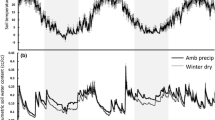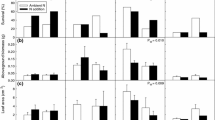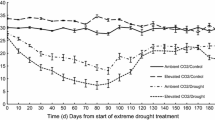Abstract
Grasslands worldwide have been invaded by woody species during the last200 years. Atmospheric CO2 enrichment may indirectly havefacilitatedinvasion by reducing soil water depletion by grasses. We used a two-stepcorrelative approach to test this hypothesis with the invasive and native shrubhoney mesquite (Prosopis glandulosa Torr. var.glandulosa). 1) Water content to 0.15 m depthwas measured in grassland exposed to a CO2 gradient from 200 to 550μmol/mol to evaluate the prediction that CO2enrichment lessens soil water depletion by grasses. 2) Soil water content andemergence and survival of mesquite seedlings were measured in adjacentgrasslandplots from which grass roots were excluded to 0.15 m depth toreduce water depletion or that were irrigated to increase soil water levels.With these measurements, we tested the hypothesis that mesquite establishmentislimited by water.Excluding grass roots doubled emergence of mesquite and almost tripledthe fraction of emergent seedlings that survived for 12 weeks following thefirst of two plantings. Seedlings were taller, heavier, and had greater leafarea when grown without grass roots. Root exclusion did not measurably affectsoil water during the 3-week period of seedling emergence, but soilwatercontent over the 12 weeks that seedling survival was studied was higher inplotsfrom which grass roots were excluded and following an April than May planting.Survivorship of mesquite seedlings correlated positively with soil watercontent. Percentage survival of seedlings increased from 1.5% to15% and 28% at the soil water content measured in grasslandexposed to CO2 concentrations of 270 (preindustrial), 360 (current),and 550 μmol/mol (future), respectively. We infer thatrecent and projected increases in atmospheric CO2 concentration maybe large enough to increase establishment of invading mesquite seedlings ingrasslands that are severely water-limited.
Similar content being viewed by others
References
Agresti A. 1996. An introduction to categorical data analysis. John Wiley & Sons, New York.
Archer S. 1989. Have southern Texas savannas been converted to woodlands in recent history? American Naturalist 134: 545- 561.
Archer S. 1994. Woody plant encroachment into Southwestern grasslands and savannas: rates, patterns and proximate causes. In: Vavra M., Laycock W.A. and Pieper R.D. (eds), Ecological implications of livestock herbivory in the West. Society for Range Management, Denver, pp. 13-68.
Archer S., Schimel D.S. and Holland E.A. 1995. Mechanisms of shrubland expansion: land use, climate or CO2? Climatic Change 29: 91-99.
Bahre C.J. and Shelton M.L. 1993. Historic vegetation change, mesquite increase, and climate in southeastern Arizona. Journal of Biogeography 20: 489-504.
Belsky A.J. 1984. Role of small browsing mammals in preventing woodland regeneration in the Serengeti National Park, Tanzania. African Journal of Ecology 22: 271-279.
Berg W.A. and Sims P.L. 1995. Nitrogen fertilizer use efficiency in steer gain on old world bluestem. Journal of Range Management 48: 465-469.
Bond W.J. and Midgley G.F. 2000. A proposed CO2-controlled mechanism of woody plant invasion in grasslands and savannas. Global Change Biology 6: 865-869.
Brown J.H., Valone T.J. and Curtin C.G. 1997. Reorganization of an arid ecosystem in response to recent climatic change. Proceedings National Academy of Science, USA 94: 9729-9733.
Brown J.R. and Archer S. 1989. Woody plant invasion of grasslands: establishment of honey mesquite (Prosopis glandulosavar. glandulosa) on sites differing in herbaceous biomass and grazing history. Oecologia 80: 19-26.
Brown J.R. and Archer S. 1990. Water relations of perennial grass and seedling vs adult woody plants in a subtropical savanna, Texas. Oikos 57: 366-374.
Brown J.R. and Archer S. 1999. Shrub invasion of grassland: recruitment is continuous and not regulated by herbaceous biomass or density. Ecology 80: 2385-2396.
Brown J.R., Scanlan J.C. and McIvor J.G. 1998. Competition by herbs as a limiting factor in shrub invasion in grassland: a test with different growth forms. Journal of Vegetation Science 9: 829-836.
Burkhardt J.W. and Tisdale E.W. 1976. Causes of juniper invasion in southwestern Idaho. Ecology 57: 472-484.
Bush J.K. and Van Auken O.W. 1990. Growth and survival of Prosopis glandulosaseedlings associated with shade and herbaceous competition. Botanical Gazette 151: 234-239.
Davis M.A., Wrage K.J. and Reich P.B. 1998. Competition between tree seedlings and herbaceous vegetation: support for a theory of resource supply and demand. Journal of Ecology 86: 652-661.
Field C.B., Lund C.P., Chiariello N.R. and Mortimer B.E. 1997. CO2 effects on the water budget of grassland microcosm communities. Global Change Biology 3: 197-206.
Harrington G.N. 1991. Effects of soil moisture on shrub seedling survival in a semi-arid grassland. Ecology 72: 1138-1149.
Jeltsch F., Milton S.J., Dean W.R.J. and van Rooyen N. 1997. Analysing shrub encroachment in the southern Kalahari: a gridbased modelling approach. Journal of Applied Ecology 34: 1497-1508.
Johnson H.B. and Mayeux H.S. 1990. Prosopis glandulosaand the nitrogen balance of rangelands: extent and occurrence of nodulation. Oecologia 84: 176-185.
Johnson H.B., Polley H.W. and Whitis R.P. 2000. Elongated chambers for field studies across atmospheric CO2 gradients. Functional Ecology 14: 388-396.
Johnston M.C. 1963. Past and present grasslands of southern Texas and northeastern Mexico. Ecology 44: 456-466.
Kirkham M.B., He H., Bolger T.P., Lawlor D.J. and Kanemasu E.T. 1991. Leaf photosynthesis and water use of big bluestem under elevated carbon dioxide. Crop Science 31: 1589-1594.
Knoop W.T. and Walker B.H. 1985. Interactions of woody and herbaceous vegetation in a southern African savanna. Journal of Ecology 73: 235-253.
McPherson G.R. 1997. Ecology and management of North American savannas. University of Arizona Press, Tucson.
McPherson G.R., Boutton T.W. and Midwood A.J. 1993. Stable carbon isotope analysis of soil organic matter illustrates vegetation change at the grassland/woodland boundary in southeastern Arizona, USA. Oecologia 93: 95-101.
Mayeux H.S., Johnson H.B. and Polley H.W. 1991. Global change and vegetation dynamics. In: James L.F., Evans J.O., Ralphs M.H. and Child R.D. (eds), Noxious range weeds. Westview Press, Boulder, pp. 62-74.
Meyer R.E. and Bovey R.W. 1982. Establishment of honey mesquite and huisache on a native pasture. Journal of Range Management 35: 548-550.
Morgan I.A., LeCain D.R., Read J.J., Hunt H.W. and Knight W.G. 1998. Photosynthetic pathway and ontogeny affect water relations and the impact of CO2 on Bouteloua gracilis(C4) and Pascopyrum smithii(C3). Oecologia 114: 483-493.
Neilson R.P. 1986. High-resolution climatic analysis and southwest biogeography. Science 232: 27-34.
Niklaus P.A., Spindler D. and Körner C. 1998. Soil moisture dynamics of calcareous grassland under elevated CO2. Oecologia 117: 201-208.
O’Connor T.G. 1995. Acacia karrooinvasion of grassland: environmental and biotic effects influencing seedling emergence and establishment. Oecologia 103: 214-223.
Owensby C.E., Coyne P.I., Ham J.M., Auen L.A. and Knapp A.K. 1993. Biomass production in a tallgrass prairie ecosystem exposed to ambient and elevated CO2. Ecological Applications 3: 644-653.
Owensby C.E., Ham J.M., Knapp A.K., Bremer D. and Auen L.M. 1997. Water vapour fluxes and their impact under elevated CO2 in a C4-tallgrass prairie. Global Change Biology 3: 189-195.
Polley H.W., Johnson H.B., Mayeux H.S. and Tischler C.R. 1996a. Are some of the recent changes in grassland communities a response to rising CO2 concentrations? In: Körner C. and Bazzaz F.A. (eds), Carbon dioxide, populations, and communities. Academic Press, San Diego, pp. 177-195.
Polley H.W., Johnson H.B., Mayeux H.S., Tischler C.R. and Brown D.A. 1996b. Carbon dioxide enrichment improves growth, water relations and survival of droughted honey mesquite (Prosopis glandulosa) seedlings. Tree Physiology 16: 817-823.
Polley H.W., Mayeux H.S., Johnson H.B. and Tischler C.R. 1997. Viewpoint: Atmospheric CO2, soil water, and shrub/grass ratios on rangelands. Journal of Range Management 50: 278-284.
Polley H.W., Tischler C.R., Johnson H.B. and Pennington R.E. 1999. Growth, water relations, and survival of drought-exposed seedlings from six maternal families of honey mesquite (Prosopis glandulosa): responses to CO2 enrichment. Tree Physiology 19: 359-366.
Schlesinger W.H., Reynolds J.F., Cunningham G.L., Huenneke L.F., Jarrell W.M., Virginia R.A. et al. 1990. Biological feedbacks in global desertification. Science 247: 1043-1048.
Scholes R.J. and Archer S.R. 1997. Tree-grass interactions in savannas. Annual Review Ecology and Systematics 28: 517-544.
Sims P.L. and Dewald C.L. 1982. Old World bluestems and their forage potential for the Southern Great Plains:Areview of early studies. ARM-S-28, USDA, ARS, New Orleans.
Stock W.D., Wienand K.T. and Baker A.C. 1995. Impacts of invading N2-fixing Acaciaspecies on patterns of nutrient cycling in two Cape ecosystems: evidence from soil incubation studies and 15N natural abundance values. Oecologia 101: 375-382.
Tischler C.R., Polley H.W., Johnson H.B. and Mayeux H.S. 1996. Effects of elevated concentrations of carbon dioxide on seedling growth of mesquite and huisache. In: Barrow J.R., McArthur E.D., Sosebee R.E. and Tausch R.J. (eds), Proceedings: Shrubland ecosystem dynamics in a changing environment. Intermountain Research Station, Forest Service, USDA, Ogden, pp. 246-248.
Topp G.C., Davis J.L. and Annan A.P. 1980. Electromagnetic determination of soil water content: measurements in coaxial transmission lines. Water Resources Research 16: 574-582.
Turner R.M. 1990. Long-term vegetation change at a fully protected Sonoran desert site. Ecology 71: 464-477.
Ueckert D.N., Smith L.L. and Allen B.L. 1979. Emergence and survival of honey mesquite seedlings on several soils in West Texas. Journal of Range Management 32: 284-287.
Van Auken O.W. and Bush J.K. 1997. Growth of Prosopis glandulosain response to changes in aboveground and belowground interference. Ecology 78: 1222-1229.
Weltzin J.F., Archer S. and Heitschmidt R.K. 1997. Small-mammal regulation of vegetation structure in a temperate savanna. Ecology 78: 751-763.
Weltzin J.F., Archer S.R. and Heitschmidt R.K. 1998. Defoliation and woody plant (Prosopis glandulosa) seedling regeneration: potential vs realized herbivory tolerance. Plant Ecology 138: 127-135.
Williams K. and Hobbs R.J. 1989. Control of shrub establishment by springtime soil water availability in an annual grassland. Oecologia 81: 62-66.
Wilson S.D. and Tilman D. 1995. Competitive responses of eight old-field plant species in four environments. Ecology 76: 1169-1180.
Author information
Authors and Affiliations
Corresponding author
Rights and permissions
About this article
Cite this article
Wayne Polley, H., Johnson, H.B. & Tischler, C.R. Woody invasion of grasslands: evidence that CO2 enrichment indirectly promotes establishment of Prosopis glandulosa . Plant Ecology 164, 85–94 (2003). https://doi.org/10.1023/A:1021271226866
Issue Date:
DOI: https://doi.org/10.1023/A:1021271226866




